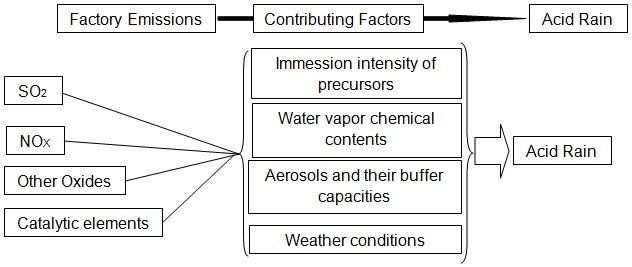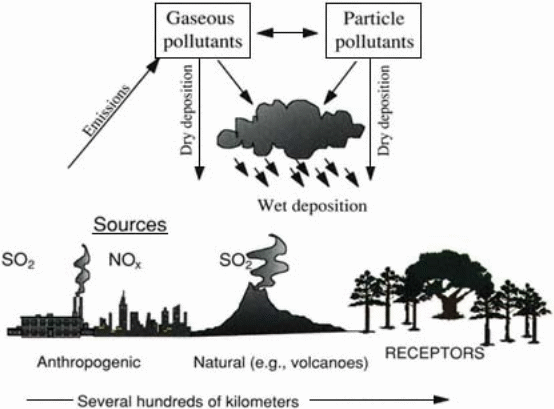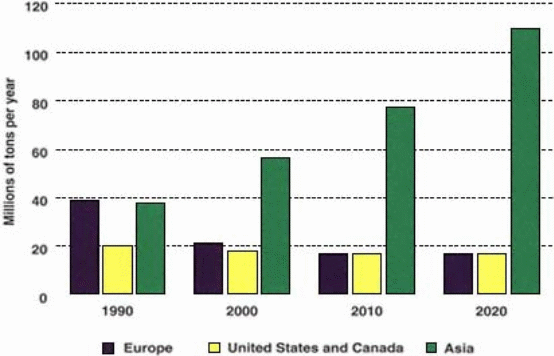Background
Tear (2007) explain that the acid rain phenomenon conceptualization dates back to 130 years ago when the relationship existing between the industrial emissions released and acid rain formation. Formation of the acid precipitation has had adverse impacts on the human health as well as the ecosystem.
dos Santos et al. (2005, p.86) explain that sources of acid rain focus on the chemical composition of main cations like Ca2+, Mg 2+, Na+, K+ and NH+4 as well as anions like SO2-4 , NO–3, Cl– and F– obtained from rainwater. Meteorological information can supplement this. Downing et al. (1997, p.29) explains how a sub-module (ATMOS- Atmospheric Transport and Deposition) that integrates data from emission sources to generate patterns of sulfur deposition, which is an agent of acid rain.
Statement of Purpose
Acid rain forms after complex chemical interaction involving the oxides of sulfur and nitrogen with the water vapor in the atmosphere. Acid rain formation has acidity far much higher than normal. Actually, acid rain contains sulfuric acid and nitric acid formed from the emission precursors- sulfur dioxide and nitrogen oxides (NOX species) (Downing et al. 1997, p.13).
Interestingly, the emission sources of the pollutants may be located a distance away from the point where the chemical interaction leading to acid rain takes place. The point of the emission is called the source area. Areas away from the source area are affected by the emission release through acid deposition are called the down-wind.
It is believed that the industrial evolution coupled with urbanization have aggravated the problem of acid rain and a rise of acidity levels in the atmosphere, notably in North America and Europe as well as south of the Bay of Bengal. However, volcanic activities have also naturally released sulfur oxides and sulfides in the air.
This form of precipitation chemistry intends to inform on the variation in the chemical composition in the atmosphere over-time and provides insights into how acid rain forms from key gases from factory emissions.
Inferences from analysis derived from rainwater composition are important for comparison with The RAINS−ASIA Model as well as establishing world cycling of sulfur compounds, oxidized and reduced nitrogen compounds, soil dust and so on (Downing et al. 1997). Through oxidation, emission pollutants from human activities (such as sulfates, NOX) have a wide range of effects.
Report Preview
The scope of the report covers factors facilitating the acid rain formation, chemical analysis, lead regional producers of acid rain as well as factory release, transportation and deposition of pollutants leading to acid rain. Information sources are empirical studies.
Factors Contributing to Acid Rain Formation
Andonova (1995) observe that in the 1970s decade Sweden and Norway were on the down-wind areas from the rest of Europe thus suffered a lot of acidification problems. The acidification problem revolved around the intensity of sulfur emissions. This called for the ratification of the First Sulfur Protocol (1985) that called for 30 percent emission cuts.
The acidity leading to acid rain depends on the relative proportions of participating cations and anions in the atmosphere. Aerosols have contributed to the stronger buttering ability of acidic rain water. Through translocation from emission points, deposition and facilitating reaction rates weather contribute to acid rain formation.

Figure 1: Conceptual Framework
SO2 and Nitrogen Oxides Processes and Evidence Leading to Acid Rain
Chemical Processes on SO2 and Nitrogen Oxides Emissions Leading to Acid Rain
Sulfur Dioxide Pollutant
During the chemical interaction, the sulfur dioxide oxidation process has two possible reaction paths. One, ultra-violet light can facilitate photo oxidation of the sulfur oxide (Seinfeld & Pandis, 2006, p.27). The electro-magnetic spectrum provides the light in the photo-oxidation process to occur.
SO2 (g) + O2 (g) → SO3 (g)
Further interaction with freely occurring hydrogen atoms in the atmosphere leads to the formation of sulfuric acid.
SO3 (g) + H2O (l) → H2SO4 (aq)
Modified from Seinfeld & Pandis (2006, p.27 & 28)
Similarly sulfur dioxide can be oxidized to become sulfuric acid through the oxidation of ozone (Seinfeld & Pandis, 2006, p.27). Photodecomposition process on the ozone produces hydroxyl radical, which reacts highly with any species.
NOX pollutants
The NOX (that is, NO2 and NO) species are emitted by during factory combustion processes involving fossil fuel and coal. NO is the initial release into the atmosphere of all reactive nitrogen (Crawford et al. 2003, p.62). In the presence of O2 Nitrogen present in fuels and oxidation of atmospheric N2 at high temperature forms NO. Small amounts of NO2 are formed in the process of NO formation. The atmospheric oxidation of NO (by hydroperoxy radicals that is, HO2) leads to NO2 formation in high quantities (Crawford et al. 2003, p.62-63). When emitted into the atmosphere, the NO and NO2 undergo simple photochemical reaction to HNO3 (acid rain) (Crawford et al. 2003, p.63). This can be explained as follows:
NO2 (g) + H2O (l) → HNO3 (aq) + HNO2
2NO2 (g) + H2O (l) →2H+ + NO3– + NO2–
NO (g) + NO2 (g) + H2O (l) →2H+ + 2NO2–
3NO2 (g) + H2O (l) →2H+ + 2NO3– + NO (g)
Modified from Crawford et al. (2003, p.62)
Evidence of Factory Emissions Leading To Acid Rain
Driscoll et al. (2007, p.27) explains that electrical processing dealers found within the western hemisphere cause the highest emissions of the anthropogenic sulfur dioxide. In the USA, sulfur dioxide release to the atmosphere that is not accounted for by the electric manufacturing is as low as 10 percent.
Driscoll et al. (2007, p.27) adds electric utilities and industrial combustions accounted for 36 percent of nitrogen oxides. In the USA, the Mid West consisting of seven states along River Ohio accounted for more than half of emissions in 2002. Such areas are known as source areas. Emission of sulfur dioxide, ammonium and nitrogen oxide was attributed to electric utilities though emissions are carried downwind eastern North America.
The US Department of Agriculture Forest Service established an experimental forest that is The Hubbard Brook in the North America to investigate the relationship between emission levels and acid deposition levels from the source area (Driscoll et al. 2007, p.33).
Findings from the experiment indicated that emission trends from the source area mirrored the acid deposition patterns. Data gathered over a long period of time at the Hubbard Brook implied a declining bulk of deposition of sulfate and wet deposition in the last five years of the 1970s decade (Driscoll et al. 2007, p.33).
This data indicates a positive association between emission of SO2 and acid rain formation taking place at the Hubbard Brook. The downwind areas of eastern USA report similar patterns of correlation of sulfur emissions and the wet sulfate deposition (Driscoll et al. 2007, p.34).
Observations made on nitrates and ammonium, levels of concentration had leveled up. Reliable sources of data came from Hubbard Brook. With regard to concentrations of nitrate or ammonium at Hubbard Brook, the levels have stabilized over time since 1963 (Driscoll et al. 2007, p.34). Correlation relationship was established between the downwind and source area for acid rain.
Figure 2: Formation of Acid rain from Factory Emissions

Source: Downing et al. (1997, p.14)
Figure 3: Present and Projected of Industrial Emissions for Sulfur Dioxide

Source: Downing et al. (1997, p.17)
Conclusion
The problem of acid rain was noted almost 130 years ago. SO2, NOX and ammonia are the main pollutants leading to the formation of acid rain.
Sulfur dioxide is emitted from combustion of coal containing sulfur. Ultraviolet light and electro-magnetic spectrum provide photo oxidation energy in the atmosphere. The resultant undergoes further chemical reaction with free hydrogen results in sulfuric acid the falls as acid rain.
Nitrogen contained in biofuels as well as atmospheric nitrogen undergo high temperature combustion that releases NO and NO2. On release to the atmosphere simple photo chemical reaction with hydroperoxy radicals results in the formation of nitric acid that falls as acid rain.
In the USA, the main sources of emissions are electric utilities. The case relation between emissions in the Midwest USA source area and the acid deposition areas of the Hubbard Brook and the downwind areas of Eastern North America explain how factory emissions lead to acid rain.
References
Andonova, L 2007, “Acid Rain in a Wider Europe: The Post-Communist Transition and the Future European Acid Rain Policies”, in G Visgilio & D Whitelaw (eds), Acid in the Environment: Lessons Learned and Future Prospects, Springer, USA, pp. 151-173.
Crawford, J, Bradshaw, J, Davis, D, & Liu, S. 2003, “Nitrogen Oxides and Other Reactive Nitrogen Species”, In T Potter & B Colman (eds), Handbook of Weather, Climate, and Water: Atmospheric Chemistry, Hydrology, and Societal Impacts, John Wiley & Sons, New Jersey, pp.61-77.
dos Santos, M, Illanes, C, Fornaro, A & Pedrotti, J 2007, ‘Acid Rain in Downtown São Paulo City, Brazil’, Water Air Soil Pollut, vol. 7, pp. 85-92, via Springer.
Downing, R, Ramankutty, R, & Shah, J. 1997. RAINS-ASIA: An Assessment Model for Acid Deposition in Asia. The World Bank, Washington, D.C.
Driscoll, C, Lambert, K & Chen, L 2007. “Acidic Deposition: Sources and Ecological Effects”, in G Visgilio & D Whitelaw (eds), Acid in the Environment: Lessons Learned and Future Prospects, Springer, USA, pp. 27-58.
Seinfeld, H & Pandis, S 2006, Atmospheric Chemistry and Physics – From Air Pollution to Climate Change, John Wiley & Sons, New Jersey.
Tear, T 2007, “Atmospheric Deposition and Conservation: What is the Role for Conservation Organizations?”, In G Visgilio & D Whitelaw (eds), Acid in the Environment: Lessons Learned and Future Prospects, Springer, USA, pp. 291-307.